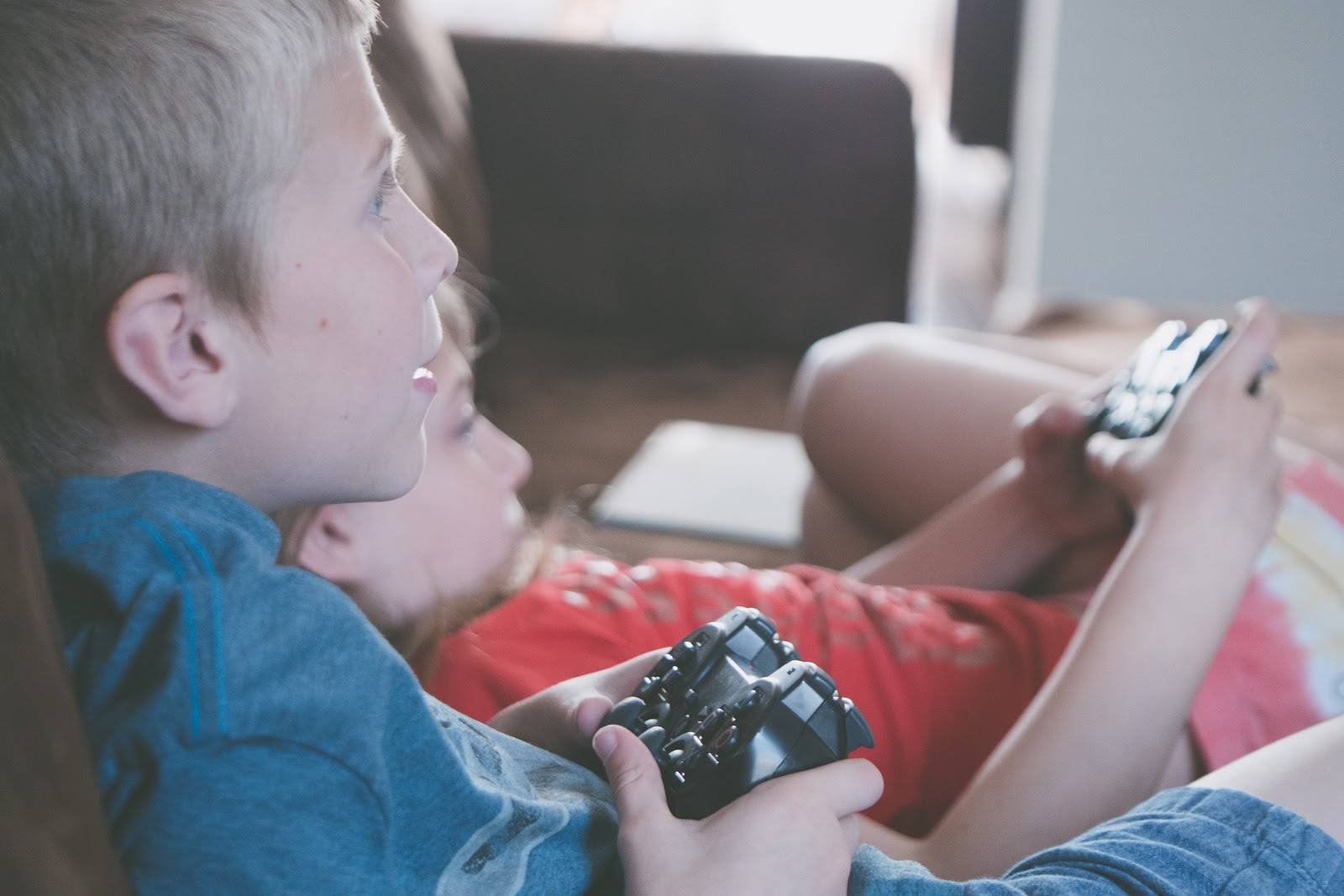Video Transcript
Julissa: Kids from getting in over their heads with video games. Courtney with our resident nerd, an avid video gamer, of course. Tips to keep the gamer playing safely.
Courtney: We don’t just have one nerd, we have 1.5 nerds today.
Julissa: 1.5?
Courtney: Yes. We’ve got Ryan Eldridge. And who’s this lovely [crosstalk 00:00:16]?
Ryan: This is Jackson Danger Eldridge.
Courtney: Jackson Danger Eldridge.
Ryan: That is his real middle name, everybody.
Courtney: I love it. You’re the coolest dad ever.
Ryan: So he’s been on the show a few times. This is what sort of, like, his expertise is Fortnite. He plays it almost every day in the morning, like, when mom and dad are sleeping in. He plays a little Fortnite. He plays it with his cousins who are up and ready, so we’ll bring him on. So let’s talk about being safe because a lot of parents they kind of plop their kids down, let them play video games and they don’t really know what’s happening. So if they’re just starting out playing video games, give them to start something that’s a little more creative and challenging like Minecraft, they build things in it. There’s not a lot like killing and slaying, like, bad stuff.
Courtney: And even the monsters aren’t super scary.
Ryan: Yeah, it’s like a sheep, you know, you hit him with a stick. And it’s pretty much done. If you’re ready to graduate a little bit, go for the LEGO games. There is some violence in there where they beat up bad guys and things. But there’s no blood or guts or anything like that and there’s still challenges. So they have to, like, work together as a team so to, like, accomplish some kind of goal or something like that. And of course, Nintendo is super easy. Like Mario, I mean, the worst thing he’s gonna do is eat a mushroom.
Courtney: Right. And kids still love Nintendo, Mario Brothers? Okay, cool.
Ryan: And Zelda. He loves Zelda, we played Zelda for a long time. So there’s nothing in there that’s really destructive. You’re not gonna get in trouble. But the kids today they’re all playing Fortnite, right? Fortnite is the thing and the thing is, it’s totally free. Just like mobile games where they can play games for free, there is some e-commerce to this kind of thing. They can spend money.
So if your credit cards are attached to your phone, your tablet or your Xbox, your Playstation, they can get in a little bit of trouble. What it is is they unlock these different tiers or different skins, one premium or one of the tiers is free, but the other one you have to pay for. And it’s really just unlock skins for your character so they can look different inside the game. Isn’t that basically what you’re paying for?
Jackson: Mm-hmm.
Ryan: And so you can kind of, like, look cool in front of all your friends and stuff.
Jackson: And different, like, skins and different dances sometimes.
Ryan: Oh, they are different things?
Courtney: Different dances, for example, the floss. Hit me with the floss.
Ryan: Can you show us real quick? Oh, that’s good.
Courtney: Over there.
Ryan: Oh, I like that. [inaudible 00:02:26] there. Oh, look at that. I like that. That’s right, America. That’s the floss. So they buy in-game coins, and they are able to buy other stuff. That’s basically the e-commerce. You wanna make sure you watch what they’re spending or don’t allow them to spend. But one of the big things is you wanna turn off voice chat. There’s a little option where you can turn it off.
Now, there’s no way to, like, password protect that. So if your kid is sort of being not really paid attention to, they can turn that back on and you wanna avoid them from being able to listen to, like, racist comments or phobic comments and things like that. So instead, let them group up inside Xbox and Playstation, they can talk to people and friends that you’ve allowed them to rather than just the average stranger online. And then you can turn on parental controls so you can kind of lock down some of the options.
Courtney: Okay, good to know because we gotta keep little guys like that safe, right?
Ryan: Yes.
Courtney: Absolutely right. Ryan, you gonna stick around the next hour?
Ryan: Yes, we’re doing phone addiction resolution.
Courtney: Ciao. I’m not looking at nobody in particular. You know, I’m just saying. Back to you.
Ryan: Got the mom face on.
Julissa: Oh, that’s funny.
Marianne: Although I did go through an Angry Birds phase way back in the day.
From Fortnite to the latest Call of Duty, there’s a ton of video game options out there, all vying for the attention, time and (of course) money of gamers.

While gaming might seem a pretty low-risk pastime on the face of things, there are some risks gamer parents really need to know about. There are lots of nasty folks and shoddy business practices out there, and sadly, the gaming community isn’t immune.
As a wise nerd once said, “forewarned is forearmed.” Here are three simple things you can do to keep the gamer in your life playing safely.
Lock Out The Chance of Accidental Purchase
Sounds weird, doesn’t it? How on earth do you accidentally purchase something?
Some games (especially those available on portable devices) are specifically designed to encourage in-app purchases. These micro-purchases can be for anything really—a cool outfit your virtual character can wear, upgrades which make winning easier, or perhaps even the option to open up whole new areas of the game.

The (kind of dastardly) thing about some of these in-app purchases is that they don’t bring up a nice big clear window saying “do you want to pay for this?” Instead, many of these games keep you immersed in the game environment, making it all too easy for the avid gamer to make an impulse buy without ever really contemplating the cost ramifications.
As you can imagine, this is especially not cool when you have young kids playing who may not have sufficient adult-smarts to even fully comprehend that they’re spending real money.
How serious can this problem be? Aren’t we just talking about a few cents here and there? Check out this story of a kid who unwittingly spent $6,000 in cold hard cash playing a popular mobile device game. It can be a pretty big deal!
In recent years, there has been a crackdown on the more nasty of these sneaky marketing methods, but they’re still out there.
So What Can You Do About It?
The big handheld tech manufacturers have been incredibly helpful, and have built into their devices secure settings for locking down the option to make in-app purchases.
With just a flick of a virtual switch, your gamer will no longer be able to authorize these kinds of purchases.
Here’s a handy guide for doing that on Apple products. And here’s a guide for Android devices.
Both will keep your kids (and your bank account) safe.
Talking To Strangers
Back in the day, a computer game was a pretty solitary affair. You sat in front of the box and immersed yourself in a virtual world.
It isn’t that way now. Most modern games support some form of socialization via voice or text chat. While this is fine most of the time, unsavory characters can jump into these chat rooms—and for most parents, this will send up a bit of a red warning flare!

Without controls in place, young gamers can easily be exposed to hateful comments, bullying, racism, homophobia, sexism, you name it.
What Are the Options for Dealing With ‘Stranger Danger’?
Again, the good news is that, with a bit of preparation and savvy, you can lock this kind of content out of your gamer’s experience.
Consoles like Xbox and Playstation actively support a “party” mode, which acts like a bit of a social firewall. It’s a limited list of people your kids actually know. Instead of playing their game with strangers, they can play with their friends. This is much safer, and actually quite a bit more fun too.
For a detailed guide on how this works in Xbox, check out this guide on Windows Central. Here’s Playstation’s guide to parental controls.
On portable devices, generally, group chat is less an issue. The lighter games offered on portable devices tend not to offer such immersive social experiences.
That being said, every game is different! And new games are being released all the time. Nothing beats close parental supervision for keeping your kids safe. If you aren’t sure your kids games are safe from unsavory characters, take the time to watch and do some of your own research.
For a few minutes effort on your part, you could be saving your kids a ton of problems.
Setting Limits
Then there’s the fact that games themselves have become incredibly good at becoming addictive. So much of modern game design—from endless leveling-up options, to character development, even to the bright, bedazzling colors they use—is specifically made that way to draw a gamer in and keep them transfixed.
And we’re talking hundreds, possibly even thousands of hours of game time.
It is incredibly easy for kids, in particular, to get sucked into gaming, but even adults fall prey. There’s an entire arm of addiction counseling now which focuses on gaming addiction and how to beat it.
How To Beat Gaming Addiction
The best thing you can do to prevent the possibility of obsessive gaming is to set limits, preferably in advance.
One parameter you may wish to consider is putting a ban on gaming on school days. Then give your gamer fan a generous chunk of dedicated gaming time on the weekends to make up for it.

Another simple option is to game WITH them! This is a win-win because you get extra cred from your kids for being that cool gamer parent, and you get to watch their gaming. If you begin to see obsessive fixation or addiction creeping in, it gives you time to do something about it before it becomes a big problem.
You may even want to consider investing in some handy hardware! The Amazon Circle Home is designed to give parents more control about how the Internet and Online gaming is used in the home. You can even set curfews, so it’s not you being the bad guy, it’s that machine in the corner!
If you are worried that your kids (or you for that matter) have a problem with gaming, it’s a really good idea to get some help. When addiction becomes full-blown, it can be a hard thing to beat.
Check out this resource curated by the American Addiction Centers. It’ll give you some solid advice and it’s a good place to start.
The most important thing to remember here is that gaming isn’t bad! In fact, there’s a bunch of evidence to suggest that gaming in moderation is good for your kids. But just like pretty much everything in this world, moderation is key. Anything can be bad for you if you have too much of it or consume it the wrong way. Gaming is no exception.
The best thing you can do for your gamer kid is to get involved. Our advice here at Nerds On Call is to make gaming a family activity! Make it something you all talk about. If you can make that effort to be informed and involved, straight away your gamer kids are going to be that much safer. And you might just have fun in the process.
Like This? We have more!
Sign up below to be kept in the loop and be sent more content like this in the future!





